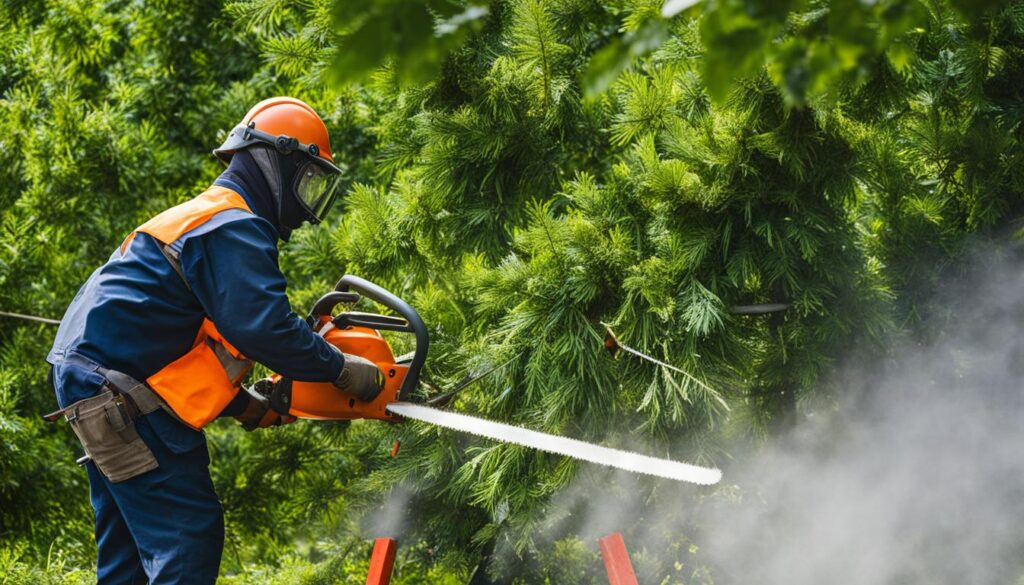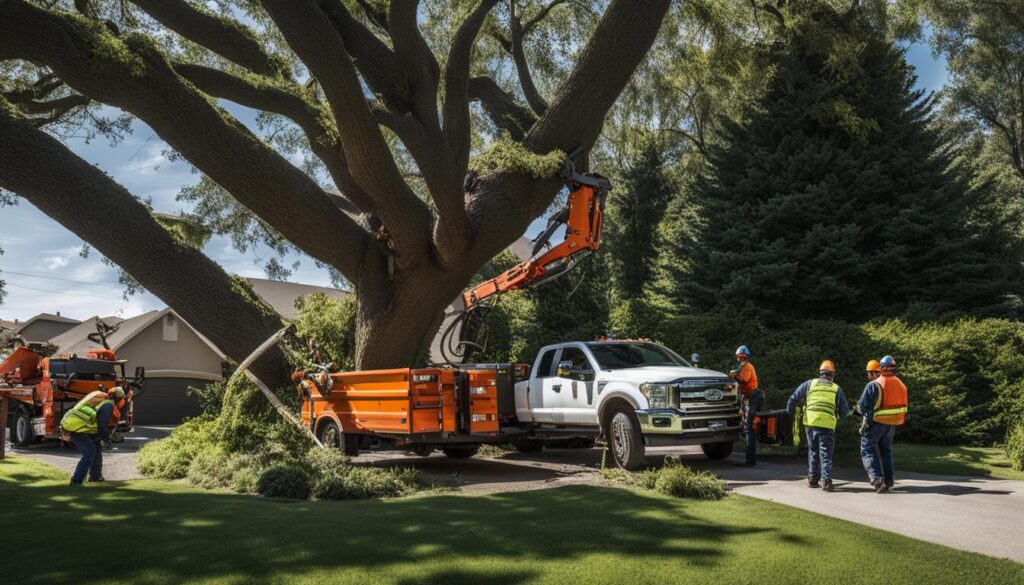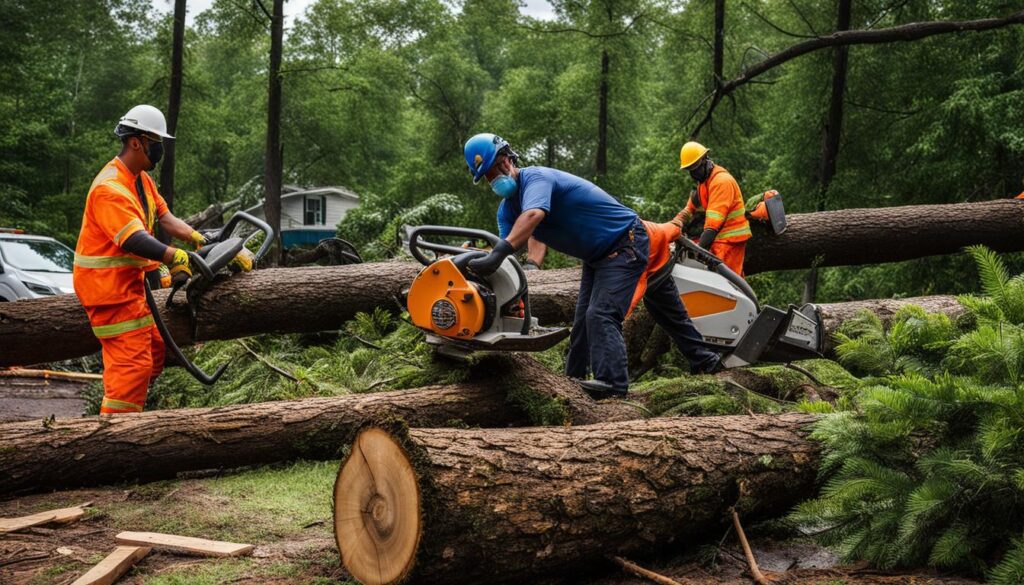For many of us who fancy taking on backyard tasks, understanding how to remove small trees is a valuable skill set to have. Whether it’s making space for a new garden feature or clearing storm damage, small tree removal can be a straightforward DIY project. Through this guide, I’ll share meticulous, safe tree removal methods to protect both yourself and your property during the process. For those moments when the job gets a bit too big to handle alone, knowing when to call in professional help can be just as important.
You might think that tree removing is as simple as cutting from any side and pulling it down, but there’s a science to doing it safely. It requires a good plan, the right tools, and a steady hand. I’m excited to guide you through each step, ensuring that you can cut down that unwelcome sapling without incident.
Key Takeaways
- Understand the precautionary steps before commencing small tree removal.
- Recognize the conditions calling for professional tree removal services.
- Familiarize with the essential tools and safety equipment needed.
- Learn the cutting techniques to remove small trees efficiently.
- Know how to assess your surroundings to avoid potential hazards.
- Plan and execute the felling direction properly for a safe removal.
Understanding the Basics of Small Tree Removal
As someone who enjoys the lushness of my backyard, I firmly believe in the stewardship of trees. However, when it comes to removing small trees effectively, an understanding of certain principles is key. To conduct tree removal how to guide ourselves through the process, we must first grasp the basics of tree anatomy and the dynamics of felling. Knowing the direction of a tree’s natural lean is pivotal; this indicates the easiest and safest direction for the tree to fall. My approach prioritizes assessing potential hazards in the surrounding area – from overhead power lines to nearby structures that could be impacted.
The decision to either proceed with DIY tree cutting methods or to call in professionals is often determined by the tree’s size and location. Safety is paramount, which is why I keep a keen eye on whether the height of the tree would require a ladder, signifying a situation better suited for experienced arborists. A larger tree, or one requiring elevation for removal, significantly increases the complexity and risk involved. In such cases, the expertise of professional services cannot be understated.
In my personal experience, I’ve found that empowerment comes from knowledge. Learning about tree cutting methods equips me with the tools to approach the task at hand confidently and responsibly. However, recognizing my limitations is also part of the learning curve – when a small tree becomes a tall order, I don’t hesitate to seek professional help to ensure the job is done safely and correctly.
Preparing for Tree Removal: Tools and Safety Equipment
As I gear up for DIY tree removal, I understand the importance of having the right tree removal tools and ensuring I’m fully equipped for safety. A reliable chainsaw and robust equipment for tree removal are paramount for a smooth operation. My focus on safety doesn’t just protect me but also ensures I am setting a standard for responsible DIY practices. Gathering my gear, I’m reminded that the proper attire and protective equipment are not just recommendations – they are vital for my protection.
Selecting the Right Chainsaw and Protective Gear
Choosing the right chainsaw is more than a matter of preference; it’s about performance and safety. I look for a model that balances power with manageability, allowing me to cut with precision without becoming fatigued. Alongside my chainsaw, my tree removal equipment checklist includes essential safety gear. A logger’s helmet with face shield, safety glasses, and noise-cancelling ear muffs are non-negotiable items for me. I also wear thick gloves and Kevlar chaps, recognizing they could mean the difference between a close call and a visit to the ER.
Ensuring Proper Function of Your Chainsaw
Before heading out to tackle the tree, I meticulously check my chainsaw’s condition. A well-maintained chainsaw not only operates more efficiently but also reduces the chance of dangerous malfunctions. I inspect the chain for sharpness and tension, the engine for proper fuel mix, and the bar for any signs of wear. It’s a ritual that serves as both a safety check and a moment of mental preparation. With my equipment verified and my focus sharp, I’m ready to apply these DIY tree removal tips safely and effectively.
Assessing the Surroundings Before Cutting Down Trees
When I discuss removing trees safely, one critical step that must not be overlooked is the assessment of your surroundings. It’s an integral part of DIY tree removal that determines whether the process can go ahead as planned. My approach involves a systematic scrutiny of the environment which includes a careful evaluation of nearby structures, power lines, and other vegetation that could fall within the trajectory of the tree once it’s cut.
Ensuring there’s no chance of damage or injury goes beyond simple observation. I do this by maintaining a clear zone that’s at least twice the height of the tree being removed—this is non-negotiable. Clearing this area of any obstacles is pivotal; otherwise, they could significantly alter the tree’s intended falling direction. It’s not just about observing the physical obstacles either, but about considering factors such as wind direction, which also play a role in tree removal techniques.
I make it a point to plan meticulously and take the time required for this crucial step; haste can turn an otherwise straightforward tree removal into a hazardous scenario. By committing to such thorough preparation, I can assure a safer environment not just for myself, but for everyone around me as well.
Planning Your Tree Felling Direction
When I’m ready to remove small trees from my property, one of my initial steps is to meticulously plan the felling direction. This crucial phase requires a careful analysis of the tree’s natural lean and any surrounding hazards that could impact the fall path. To perform tree removal DIY, it’s essential to harness the tree’s natural tilt to my advantage—guiding the fall process to ensure the safest outcome. It’s about working with nature, not against it, to achieve a controlled and predictable descent.
Analyzing Tree Lean and Hazards
My eyes are always the first tools I deploy. I observe the tree’s lean, scrutinizing it for signs that point to the safest fall direction. In the process, I take into account everything from wind patterns to nearby structures that could pose potential risks. The aim here is clear: to make well-informed decisions that will prevent property damage and, more importantly, protect personal safety.
Establishing Clear Escape Routes
Apart from planning the fall of the tree, establishing clear escape routes is a step I never overlook. These getaway paths are positioned at about 45-degree angles from where I expect the tree to land. Having these escape routes provides me a swift exit strategy in the unexpected event that the tree begins to fall prematurely or veers off course. My safety—and the safety of any bystanders—depends on this foresight.
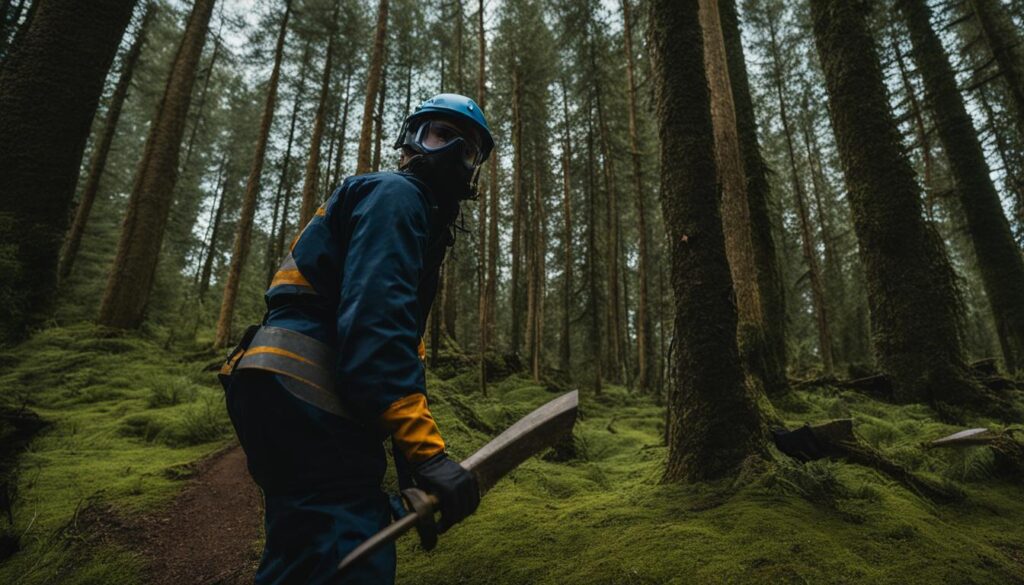

The aforementioned steps to remove small trees demand a high level of attentiveness and preparation. As I mark each phase of the preparation, I’m reminded that the successful felling of a tree isn’t just a matter of cutting it down; it’s a testament to precise calculation and a commitment to executing tree removal DIY securely.
Making the First Cuts: Notching Techniques
When it comes to the pivotal steps in tree removal how to, creating a proper notch at the beginning of the process is paramount. I ensure my initial cut on the side of the tree where I want it to fall is at a downward angle, usually around 70 degrees. This cut goes approximately one-quarter of the way through the tree and is the start of what will become the directional notch. I follow this with a horizontal cut that meets the endpoint of my first cut, thereby creating a wedge that can be removed. This notch is the guide that will determine the direction of the tree’s fall and is an indispensable method among tree cutting methods.
While cutting down small trees, precision in these cuts isn’t just about effectiveness; it’s about safety as well. It’s essential that the two cuts meet precisely; if they don’t, the tree could fall in an unintended direction, causing potential damage or injury. Any uncertainty in this phase prompts me to stop and reassess, considering the help of professional tree removal services if necessary.
Executing the Felling Cut Safely
As I position myself to make the crucial felling cut, my focus on safety intensifies. Employing safe tree removal methods at this stage is non-negotiable to ensure that the process of removing the small tree effectively is not only accurate but also minimizes risk to myself and my surroundings. It’s a delicate balance of applying the right tree removal techniques and knowing precisely when to step back to safety.
Positioning and Using Felling Wedges
For larger trees, positioning and using felling wedges becomes essential. These wedges assist in guiding the tree’s fall and prevent my chainsaw from becoming lodged in the cut. As I drive the wedges into the kerf, I am vigilant, watching the tree’s response to each tap of my hammer. My every move is calculated, with an eye always on the tree’s lean and the wedge’s placement.
Recognizing the Right Time to Retreat
The moment the tree begins to lean, signaling its descent, recognizing the right time to retreat is crucial. It’s part of the safety protocol I’ve ingrained in myself; my escape route is clear in my mind, previously established and unobstructed. An assistant, always at a safe distance, serves as an extra set of eyes, ready to signal when the tree’s movement necessitates my immediate retreat to safety.
How to Remove Small Trees: Essential Cutting Strategies
When I decide to tackle the challenge of **how to remove trees**, particularly smaller ones, from my landscape, it’s crucial that I approach the task equipped with the right **diy tree removal tips**. My primary focus is on safety and efficiency, ensuring each step is completed without causing harm to myself or my property. The process often begins at the base of the tree, where I carefully remove branches to prevent **kickback** or unexpected releases of tension. A kickback can happen when the chainsaw blade catches and is propelled back toward me, which is a common and dangerous occurrence if not handled correctly.
Branches aren’t the only concern; **tree stump removal** is another aspect I consider. While I might not remove the stump immediately after felling the tree, preparing for this step is part of the process. Moving on to the main trunk, the offset cutting technique serves me well; it involves cutting halfway through the log first, then flipping it to complete the cut from the other side. This method helps prevent the chainsaw from binding in the wood, offering me more control and reducing the risk of mishaps.
As I share these insights, it’s evident that removing small trees requires careful planning and execution. Not only does it sustain the health and beauty of my surroundings, but it also ensures that I am undertaking this task with respect for the environment and personal safety. Remember, whether it’s for aesthetic purposes, safety, or tree health, being informed and prepared makes all the difference in **diy tree removal**.
Post-Felling Procedures: Removing Tree Limbs
Once the tree has been felled, I find myself facing the critical task of limb removal. My approach to this process revolves around safety and efficiency, as removing small trees effectively requires meticulous technique and awareness. The branches, often under tension, need considered handling to mitigate any risk of snapping back or causing injury.
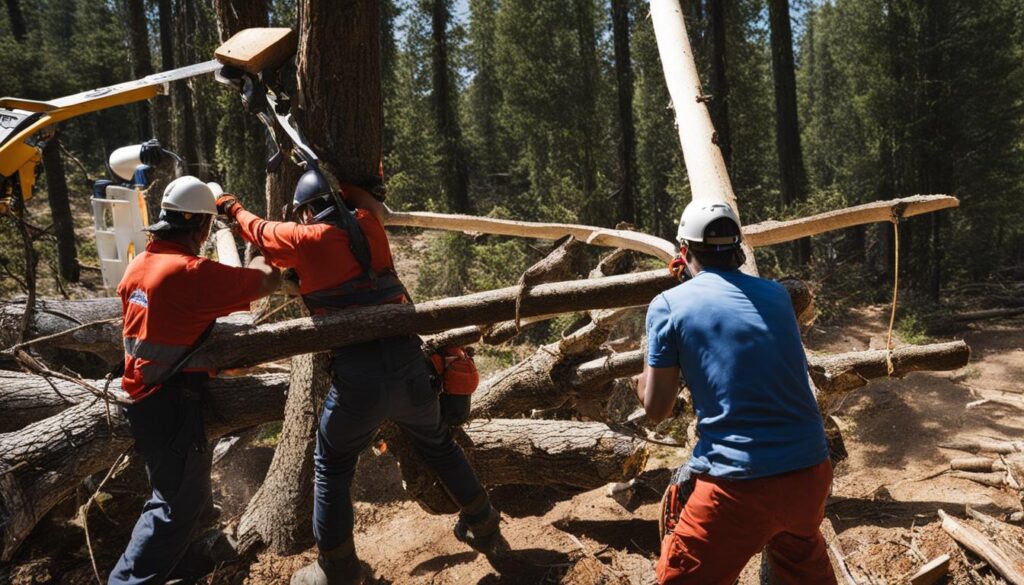

Dealing with Tension in Tree Limbs
In my experience, the tensioned limbs of a tree can create a hazardous situation if not addressed properly. I follow a two-cut technique which allows me to control the release of tension. This begins with an initial shallow cut on the tension side of the limb, allowing it a bit of movement and revealing the true point of tension. Following this, I make a second cut on the opposite side to remove the limb safely. Through this method, I ensure that the saw doesn’t bind and the limb doesn’t snap uncontrollably.
Directional Cutting to Prevent Kickback
Furthermore, directional cutting plays an indispensable role in my tree removal techniques. By carefully selecting the direction in which each limb will fall and creating cuts that guide them in that direction, I prevent situations that could lead to dangerous kickback. Not only does this safeguard my well-being, but it also keeps the work area clear of unpredictably falling limbs. Utilizing these strategies allows me to approach tree removal DIY projects with confidence while removing trees safely and effectively.
Safely Sectioning the Tree Trunk for Removal
After I’ve diligently cut down the tree and meticulously removed the branches, I face the next critical phase: sectioning the trunk for easy removal. My primary focus here is operating safely and efficiently, given that incorrect techniques not only jeopardize my safety but also potentially damage my equipment. That’s where DIY tree removal skills come to the forefront. I size up the trunk, gauging the weight and determining just how to slice it into more manageable sections, whether for disposal or preparing it for use as firewood.
The key is to plan the cuts to ensure that each section is not too heavy or unwieldy, taking into account the tree removal cost estimation. Optimizing the size of each section can save on costs when disposing of the wood or when splitting it for firewood. The process requires a combination of strength, precision, and the right technique to avoid potential hazards. When I’m removing trees safely, I understand that this stage shouldn’t be rushed. It’s about making sure each segment is cut cleanly and falls away without causing injury or damage to the surroundings.
Getting this right not only guarantees efficiency but also underscores the value of DIY efforts in managing tree remnants. As I proceed, I continue to stay vigilant, making sure my immediate environment supports safe sectioning and that my tools remain in optimal condition throughout the task. While the tools do much of the physical work, it’s my strategy and foresight that ensure the job is completed effectively and my yard is left safe and clean.
When to Call Professional Tree Removal Services
Sometimes, the task of tree removal escalates beyond what I can handle with my set of skills. It’s in circumstances like these that I know it’s time to turn to professional tree removal services. The decision to hire experts is influenced by numerous factors, especially when the complexity of removal might pose a risk to my property or personal safety. The expertise of a licensed arborist becomes invaluable in such scenarios, where the tree removal cost is justified by the assurance of safety and legality.
Evaluating Tree Removal Complexity
Assessing the complexity of tree removal involves more than just the size of the tree; it’s about recognizing the potential challenges like proximity to power lines, accessibility issues, and other risks. In cases where trees are entangled in complex landscapes or where precision is crucial to avoid property damage, I understand the need to step back and let professionals handle the situation. It’s not just removing the tree that’s at stake; it’s doing it in a way that ensures the safety of everything, and everyone, around it.
Benefits of Hiring a Licensed Arborist
The benefits of hiring a licensed arborist extend far beyond the convenience. These seasoned professionals come equipped with the necessary tools, knowledge of local regulations, and carry insurance to mitigate any unexpected consequences. Their expertise also ensures that the tree is removed responsibly, without threats to local wildlife or the surrounding ecosystem. On a financial note, investing in professional tree removal services can prevent incurring additional costs due to potential property damage that might occur if I attempted the task without the proper skills or tools. For me, this peace of mind is a significant factor in choosing to hire a licensed arborist.
Calculating Your Tree Removal Cost Estimation
As I prepare to clear my yard of an old maple that has been a fixture for countless seasons, the reality of tree removal cost becomes all too relevant. It’s not simply a matter of mustering up some courage and grabbing a chainsaw; there’s a financial side to this arbor equation that requires attention.
Through my research, I’ve come to understand that a tree removal cost estimation hinges on the tree’s towering height, sprawling width, and the complexity nestled within its branches. Is it entangled with power lines? Does its vast root network threaten the nearby sidewalk? The answers to such questions feed into the final figure on that bill.
I’ve engaged with professional tree removal services, knowing that companies like Phoenix Trim-A-Tree don’t just wield chainsaws with expertise; they offer the peace of mind that comes from licensed, insured interventions. From the posture of the tree to the peculiarities of the landscape, these seasoned arborists assess all variables, ensuring a cost tailored to the task at hand. And quite conveniently, they often provide these estimates without charge, allowing me to navigate my budget with greater clarity.
In contemplating the balance between hiring experts and the DIY path, it’s not just about dollars and cents. It’s about valuing the safety of my family, the protection of our home, and the time that would otherwise be spent in navigating this leafy giant’s descent. For now, I’m inclined towards the wisdom of entrusting this task to those whose daily grind is measured in rings and roots.
Conclusion
In summarizing the comprehensive guide on DIY tree removal, I’ve outlined the foundational steps and considerations that are crucial for anyone endeavoring to tackle the job of removing small trees. The journey begins with an intimate knowledge of tree physiology, ensuring careful planning and preparation with appropriate tools and protective gear. Each section of this guide has underscored the substantial role that safety plays in the tree removal process.
Summarizing DIY Tree Removal Tips
The successful removal of a small tree on your property hinges on the array of tips provided throughout this article. From choosing the right equipment for tree removal to executing precise cutting techniques, these insights have been meticulously curated to arm you with the necessary skills. Adhering to these DIY tree removal tips not only streamlines the process but also amplifies your confidence in managing such arborous tasks independently.
Reinforcing the Importance of Safety
As I’ve emphasized repeatedly, safety is not just a consideration; it’s an imperative. The safe tree removal methods discussed are designed to protect you, others, and your property from potential hazards. While DIY can be rewarding and cost-saving, the complexity of certain situations may call for professional tree removal services. My guidance is provided with the intent that every step you take in tree removal is prefixed with caution and foresight, ensuring that the end result is both effective and secure.
FAQ
How do I safely remove a small tree?
To safely remove a small tree, you’ll need to have a clear understanding of the tree’s natural lean, assess any surrounding hazards, and use the correct cutting techniques. Ensure you have the appropriate safety gear and tools such as a chainsaw, safety glasses, and ear protection, and follow the tree removal process step by step, emphasizing safety throughout. As a precaution, establish clear escape routes before making the cuts. If at any point the task seems too complex, do not hesitate to call professional tree removal services.
What tools do I need for DIY small tree removal?
You will need several tools for DIY small tree removal, including a well-functioning chainsaw, protective gear such as a logger’s helmet, safety glasses, Kevlar chaps, and gloves. Make sure your chainsaw is sharp and operational. Additionally, for larger trees, felling wedges might be necessary to prevent the chainsaw from getting stuck. It’s also a good idea to have a first aid kit on hand in case of accidents.
How do I determine the felling direction for a tree?
Determine the felling direction by examining the tree’s natural lean and any asymmetry in the branch structure. Take into account environmental factors such as wind direction and potential hazards in the area, including buildings, power lines, and other trees. Plan to make your cuts so the tree falls in the safest, most controlled manner possible, ideally complementing its natural lean to ease the process.
What are the basic notching techniques for tree removal?
The basic notching techniques involve creating a notch on the side of the tree facing the direction you want it to fall. Start with a horizontal cut, then a sloping cut to meet the first cut, forming a wedge. The notch should be about one-quarter of the tree’s diameter in depth. Proper notching helps control the tree’s fall and reduces the risk of it falling in an unpredicted direction.
When should I retreat during the tree felling process?
Retreat during the tree felling process when you notice the tree starting to lean and the felling cut begins to open. Always move quickly and safely along one of the pre-established escape routes at a 45-degree angle from the falling tree. An assistant observing from a safe distance can be useful to signal when it’s time to retreat.
How can I deal with tension in tree limbs after felling?
Dealing with tension in tree limbs requires careful assessment and technique. Use the two-cut method, where you cut partially through the limb from the bottom and then complete the cut from the top. This method helps prevent the saw from getting pinched and controls the release of tension. Never stand directly behind the limb as you cut and be alert for any unexpected movement.
What is the importance of directional cutting?
Directional cutting is important to safely control the fall of branches and sections of the tree. By cutting in a specific direction, you guide the wood to fall in a predetermined area, minimizing the chance of it kicking back toward you or falling unpredictably. This technique is essential for maintaining control and ensuring personal safety during the tree removal process.
When is it best to call professional tree removal services?
It’s best to call professional tree removal services when the tree is large or located in a hazardous area, the removal process poses a risk of property damage or injury, or when you lack the necessary skills, experience, or tools. Professionals are trained to handle complex situations safely and are insured against potential damage, which provides peace of mind.
How do I estimate the cost of tree removal?
Estimating the cost of tree removal depends on several factors including the tree’s size, location, and the complexity of the removal. Contact professional tree removal services to get a free estimate. They consider all variables and provide a detailed quote, helping you decide whether to proceed with DIY removal or hire a professional service.

